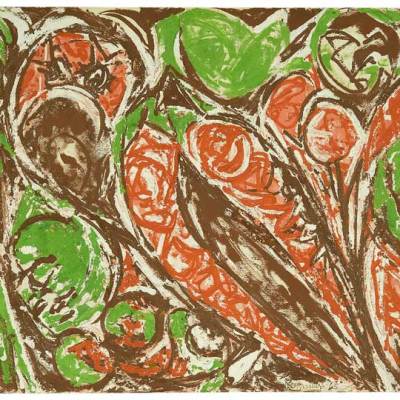‘Cézanne and the Modern’ opens at the Ashmolean Museum on Wednesday. Curator Colin Harrison introduces the exhibition, which showcases work from the extraordinary collection of Henry and Rose Pearlman.
Click here for a gallery of images from the exhibition
Can you tell us a bit about the exhibition?
The Pearlman Collection is one of the most remarkable collections of Impressionist and post-Impressionist art in the world. It was formed by Henry and Rose Pearlman over a period of 30 years, from 1945 until his death in 1974. Although he began with a landscape by Soutine, the greatest strength of the collection is the astonishing group of watercolours by Cézanne, including his very last, a magical still life, made shortly before his death.
What makes this a distinctive show?
Although the collection has been on loan to the Princeton University Art Museum since 1974, and one or two of the major works have been lent to monographic exhibitions in Europe and the US, this is the first time that it will be shown in its entirety. The Ashmolean is the first venue in a tour that will also include the Musée Granet at Aix-en-Provence, and two museums in North America.
How did you come to curate this exhibition?
I have been a curator in the Ashmolean for nearly 20 years, with a particular responsibility for British and French paintings, prints, and drawings. The works in the Pearlman Collection fall naturally within my range.
What is likely to be the highlight of the exhibition?
There are so many masterpieces that it is difficult to choose! The two late Cézanne oils, including one of the greatest views of the Mont Sainte Victoire, are very special. And the Van Gogh is extraordinary. However, the quality of every work, and its state of preservation, is outstanding.
And what’s been the most exciting personal discovery for you?
Pearlman began with Soutine, and eventually amassed no fewer than seven paintings by this artist. Since the British have never really understood his work, there are very few pictures by him in public collections in this country. So the opportunity to look at the whole range of his painting, from landscape to still life to portraits, including a portrait of himself at the end of the First World War, is particularly exciting. The Soutines are especially interesting when displayed with the paintings and sculptures of two of his friends and contemporaries, Modigliani and Lipchitz.
Self-portrait (c.1918), ChaÏm Soutine © The Henry and Rose Pearlman Collection. Photography by Bruce M. White

Click here for more curators’ First Looks…
What’s the greatest challenge you’ve faced in preparing this exhibition?
Pearlman was not an art historian, though he did a great deal of research on his pictures and even visited the sites depicted byCézanne in his oils and watercolours. We know from photographs of his office and residences that he arranged the collection in a very personal manner, juxtaposing Modigliani with Van Gogh and Cézanne with Soutine. These comparisons are immensely interesting, but we decided that a more straightforward historical hang would work better in the Ashmolean.
How are you using the gallery space? What challenges will the hang/installation pose?
The three galleries for temporary exhibitions in the Ashmolean are all different in size, shape, and height. We had to think very carefully about the disposition of the pictures, and the division between the galleries. In the event, the collection seemed to hang itself, so to speak. So, we have one gallery of Cézanne, with the watercolours and the four ‘unfinished’ oils; the central gallery with the Impressionists and post-Impressionists, single examples by Pissarro, Sisley, and others, and the two great late Cézannes; and the final gallery devoted to the foreign artists who moved to Paris before the First World War; Modigliani, Soutine, and Lipchitz. Henry Pearlman had his portrait painted by Oskar Kokoschka, which opens the exhibition; and sculpted by Lipchitz, the bust which closes it.
The greatest challenge was to make the central gallery, whose immense height is not really needed for the display of oil paintings, less cavernous. We have done this by painting the walls red up to a certain level, and leaving the top grey, in effect creating a fictive gallery within the gallery.
Which other works would you have liked to have included?
The only major work from the collection that is not being shown in Oxford is Toulouse-Lautrec’s parody of The Sacred Grove by Puvis de Chavannes, which was simply too big to get into the Ashmolean!
Click here for a gallery of images from the show
‘Cézanne and the Modern: Masterpieces of European Art from the Pearlman Collection’ is at the Ashmolean Museum, Oxford, from 13 March–22 June.



